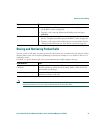
Advanced Call Handling
Cisco Unified IP Phone 7905G and 7912G for Cisco Unified CallManager 5.0 (SCCP) 35
• If all other phones that share the same line have Privacy enabled, you can still make new calls using
the shared line. However, you cannot join any in-progress calls using the shared line.
Tracing Suspicious Calls
If you are receiving suspicious or malicious calls, your system administrator can add the Malicious Call
Identification (MCID) feature to your phone. This feature enables you to identify an active call as
suspicious, which initiates a series of automated tracking and notification messages.
Prioritizing Critical Calls
In some specialized environments, such as military or government offices, you might need to make and
receive urgent or critical calls. These critical calls might require higher priority handling, such as being
able to bypass other calls. If you have the need for this specialized call handling, your system
administrator can add Multilevel Precedence and Preemption (MLPP) to your phone.
Keep these terms in mind:
• Precedence indicates the priority associated with a call.
• Preemption is the process of ending an existing, lower priority call while accepting a higher
priority call that is sent to your phone.
If you want to... Then...
Identify a suspicious call Press MCID. If the MCID request is successful, you will hear
a special tone and see the message, “MCID successful” on
your phone. The call remains active until you end the call.
If you want to... Then...
Choose a priority (precedence) level
for an outgoing call
Contact your system administrator for a list of corresponding
precedence numbers for calls (ranging from low to highest).
Make a priority (precedence) call Enter the MLPP access number (which is provided by your
system administrator) followed by the phone number.
Receive a priority (precedence) call Hear the special call waiting tone and note the special icon
displayed for the incoming call.


















